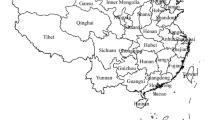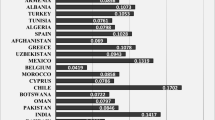Abstract
This paper details an application of the Water Poverty Index (WPI), a holistic tool for water resources planning and management, to evaluate the water resources situation in urban and rural areas in China. In using the WPI, we selected twelve indicators and twelve variables to reflect the situation in these areas. The results of our analysis show that WPI varies widely in both urban and rural areas, suggesting the need for location-specific policy interventions. In addition, this paper establishes a harmonious and developmental (H-D) model to analyze the water poverty situation of urban and rural areas. Using a temporal-spatial perspective, this paper analyses the causes of variation in H-D ability, and defines four levels of H-D ability through the clustering method. These research findings are intended to provide a theoretical foundation for policies to resolve conflicts of water use in the context of China’s dualistic urban and rural structure.




Similar content being viewed by others
References
Abrams L (1999) Poverty and water supply and sanitation services. Paper delivered at the regional workshop on financing community water supply and sanitation. White River, South Africa
Agustí PF, Ricard G (2011) Analyzing water poverty in basins. Water Resour Manag 25:3395–3612. doi:10.1007/s11269-011-9872-4
Alexander KS, Moglia M, Miller C (2010) Water needs assessment: learning to deal with scale, subjectivity and high stakes. J Hydrol 388:251–257
Appelgren B, Klohn W (1999) Management of water scarcity: a focus on social capacities and options. Phys Chem Earth PArt B 24(4):361–373
Bosch C, Hommann K, Rubio GM, Sadoff C, Travers L (2001) Water, sanitation and poverty. In: Poverty reduction strategy sourcebook. World Bank, Washington DC
Brooks N, Adger WN, Kelly PM (2005) The determinants of vulnerability and adaptive capacity at the national level and the implications for adaptation. Glob Environ Chang 15:151–163
Council S (2012) The “twelfth Five-year” plan of marine economic development (accessed 16.09.12.)
Falkenmark M, Widstrand C (1992) Population and water resources: a delicate balance. Popul Bull 47(3):1–36
Hamouda MA, Nour El-Din MM, Moursy FI (2009) Vulnerability assessment of water resources systems in the Eastern Nile Basin. Water Resour Manag 23:2697–2725. doi:10.1007/s11269-009-9404-7
Han H, Zhao L (2005) Rural income poverty in Western China is water poverty. China World Econ 13(5):76–88
Howard G, Bartram J (2003) Domestic water quantity, service, level and health. World Health Organization, Geneva
Hu JT (2012) Full text of report at 18th party congress. The xin hua news agency, Beijing
Huang IB, Keisler J, Linkov I (2011) Multi-criteria decision analysis in environmental sciences: Ten years of applications and trends. Sci Total Environ 409:3578–3594
Hwang CL, Lin MJ (1987) Group decision making under multiple criteria. Springer
James L, Wescoat JR, Lisa H, Rebecca T (2007) Water and poverty in the United States. Geoforum 38:801–814
Joint Monitoring Programme (2010) Progress on sanitation and drinking-water: 2010 Update. Joint monitoring programme for water supply and sanitation. WHO/UNICEF, Geneva
José AS, Juan R, Juan M (2015) Water productivity in a Mediterranean semi-arid greenhouse district. Water Resour Manag 29:5395–5411. doi:10.1007/s11269-015-1125-5
Masoumeh F, Ezatollah K (2011) Agricultural water poverty index and H-D ability. Agron Sustain Dev 31:415–432
Molle F, Mollinga P (2003) Water poverty indicators: conceptual problems and policy issues. Water Policy 5(5):529–544
Namara RE, Hanjra MA, Castillo GE, Ravnborg HM, Smith L, Koppen BV (2010) Agricultural water management and poverty linkages. Agric Water Manag 97:520–527
Nardo M, Saisana M, Saltelli A, Tarantola S, Hoffman A, Giovannini E (2005) Handbook on constructing composite indicators: methodology and user guide. OECD Statistics Working Paper, Paris
NBSC (1997–2013) China statistical yearbook. China Statistic Press, Beijing
Ohlsson L (2000) Water conflicts and social resource scarcity. Phys Chem Earth 25(3):213–220
Pandey VP, Shrestha S, Chapagain SK, Kazama F (2011) A framework for measuring groundwater H-D ability. Environ Sci Pol 14:396–407
Qin XH, Sun CZ, Zou W (2015) Quantitative models for assessing the human-ocean system’s sustainable development in coastal cities: the perspective of metabolic-recycling in the Bohai Sea Ring Area, China. Ocean Coast Manag 107:46–58
Rijsberman F (2003) Can development of water resources reduces poverty? Water Policy 5:399–412
Ronchi E, Federico A, Musmeci F (2002) A system oriented integrated indicator for sustainable development in Italy. Ecol Indic 2:197–210
Satterthwaite D (2003) The links between poverty and the environment in urban areas of Africa, Asia, and Latin America. Ann Am Acad Pol Soc Sci 590:73–92
Schulze RE (2007) Some foci of integrated water resources management in the “South” which are oft-forgotten by the “North”: a perspective from southern Africa. Water Resour Manag 21:269–294. doi:10.1007/s11269-006-9053-z
Shanian A, Savadogo O (2009) A methodological concept for material selection of highly sensitive components based on multiple criteria decision analysis. Expert Syst Appl 36:1362–1370
Su X, Li J, Singh V (2014) Optimal allocation of agricultural water resources based on virtual water subdivision in Shiyang River Basin. Water Resour Manag 28:2243–2257. doi:10.1007/s11269-014-0611-5
Sujata M, Vishnu PP, Futaba K (2012) Application of Water Poverty Index (WPI) in Nepalese context: a case study of Kali Gandaki River Basin (KGRB). Water Resour Manag 26:89–107. doi:10.1007/s11269-011-9907-x
Sullivan CA (2001) The potential for calculating a meaningful water poverty index. Water Int 26:471–480
Sullivan CA (2002) Calculating a water poverty index. World Dev 30(7):1195–1210
Sullivan CA, Hatem J (2014) Toward understanding water conflicts in MENA region: a comparative analysis using water poverty index. Econ Res Forum 8:1–24
Sullivan CA, Meigh J (2007) Integration of the biophysical and social sciences using an indicator approach: addressing water problems at different scales. Water Resour Manag 21(1):111–128. doi:10.1007/s11269-006-9044-0
Sun CZ, Tang WJ, Zou W (2012) Measure of water poverty conditions and its spatial pattern mechanism in China’s rural areas. Geogr Res 31(8):1445–1455
United Nations Educational, Scientific and Cultural Organization (UNESCO)-WWAP (2006) Water a shared responsibility, The United Nations world water development report 2.UNESCO/Berghahn Books, Paris/New York
Vishnu PP, Sujata M, Futaba K (2012) Water poverty situation of medium-sized river basins in Nepal. Water Resour Manag 26:2475–2489. doi:10.1007/s11269-012-0027-z
Wang XN, Sun CZ, Zou W (2011) Coupling relation analysis between water poverty and economic poverty in China. China Soft Sci 12:180–192
Weingartner R (2003) Water: a scarce resource in rural watersheds of Nepal’s Middle mountains. Mt Res Dev 23(1):41–49
Wilk J, Jonsson AC (2013) From water poverty to water prosperity—a more participatory approach to studying local water resources management. Water Resour Manag 27:695–713. doi:10.1007/s11269-012-0209-8
Yang H, Zhang X, Zehnder AJB (2003) Water scarcity, pricing mechanism and institutional reform in northern China irrigated agriculture. Agric Water Manag 61:143–161
Yokwe S (2009) Water productivity in smallholder irrigation schemes in South Africa. Agric Water Manag 96:1223–1228
Zhang Y, Yang Z, Li W (2006) Analyses of urban ecosystem based on information entropy. Ecol Model 197:1–12
Acknowledgments
This research was funded by the Ministry of Education’s Program for New Century Excellent Talents in University (NCET-13-0844). We appreciate the constructive suggestions and comments on the manuscript from the reviewer(s) and editor(s).
Author information
Authors and Affiliations
Corresponding author
Rights and permissions
About this article
Cite this article
Sun, C., Liu, W. & Zou, W. Water Poverty in Urban and Rural China Considered Through the Harmonious and Developmental Ability Model. Water Resour Manage 30, 2547–2567 (2016). https://doi.org/10.1007/s11269-016-1290-1
Received:
Accepted:
Published:
Issue Date:
DOI: https://doi.org/10.1007/s11269-016-1290-1




